Walt Disney was an international celebrity by the time he was 30 and hailed a genius before he was 40, with honorary degrees from Harvard and Yale. He was also a son, a brother, a father, and a husband. Disney traveled the world and lived in cities like Chicago and Los Angeles, but he would forever call the small town of Marceline, Missouri "home." Browse a gallery of personal images of Walt Disney, from his humble beginnings in the American Midwest, to Hollywood and Disneyland in Anaheim, to the future home of his "Experimental Prototype Community of Tomorrow" (EPCOT), in Florida.
-

Walter Elias Disney was born on December 5, 1901 in Chicago, Illinois. He was the fourth of Elias and Flora Disney's five children. Here, Walt poses with his younger sister Ruth in 1906.
Credit: Courtesy of the Walt Disney Archives Photo Library -
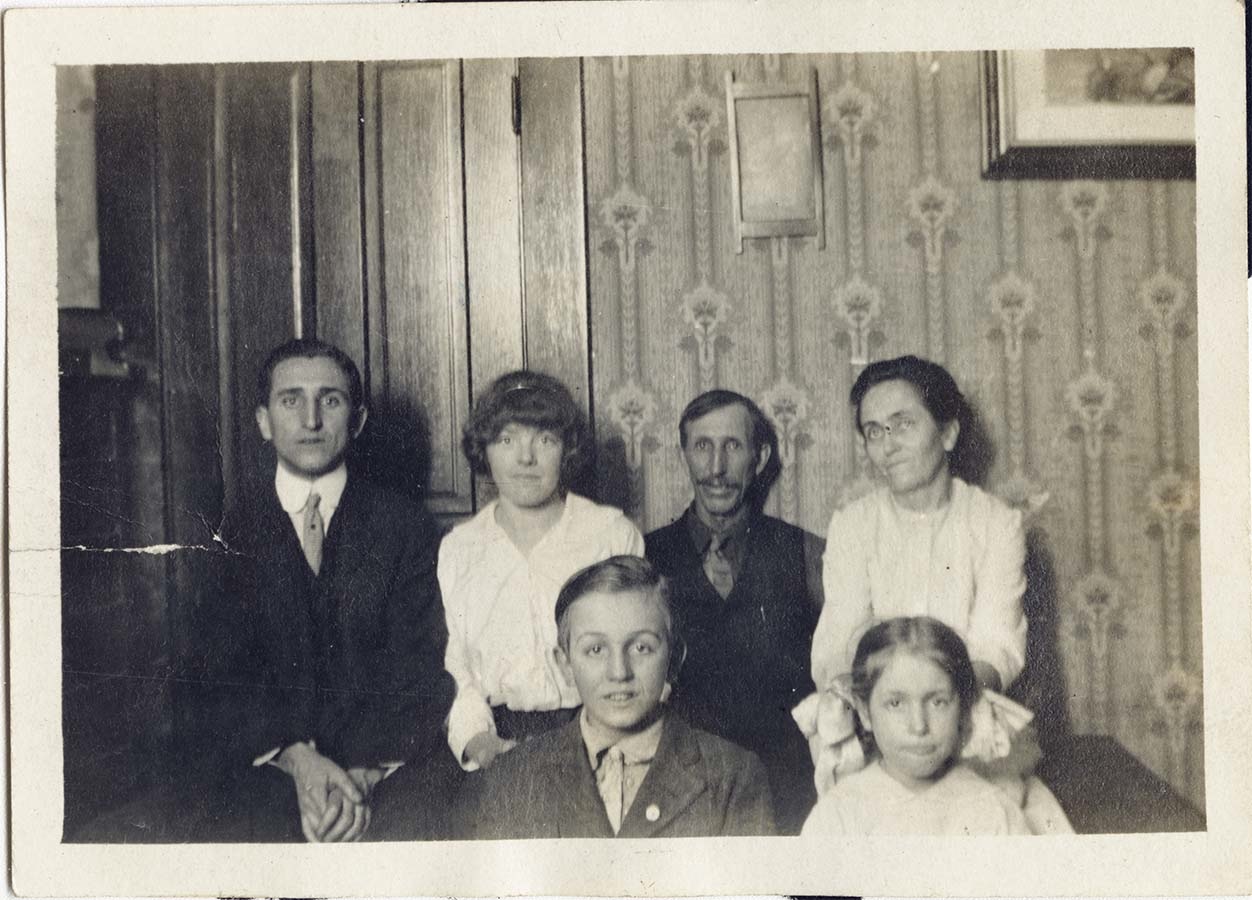
The Disney family poses for a portrait in 1915, probably seated inside their Bellefontaine home in Kansas City. From left to right in back row: Herbert, Louise, Elias, and Flora Disney. Walt and Ruth are seated in front row.
Credit: Walt Disney Family Museum -

Walt Disney was a playful and energetic boy who always seemed to be the center of attention. Here, he and his friend Walt Pfeiffer dressed up as Abe Lincoln, circa 1912-1914.
Credit: Courtesy of the Walt Disney Archives Photo Library -
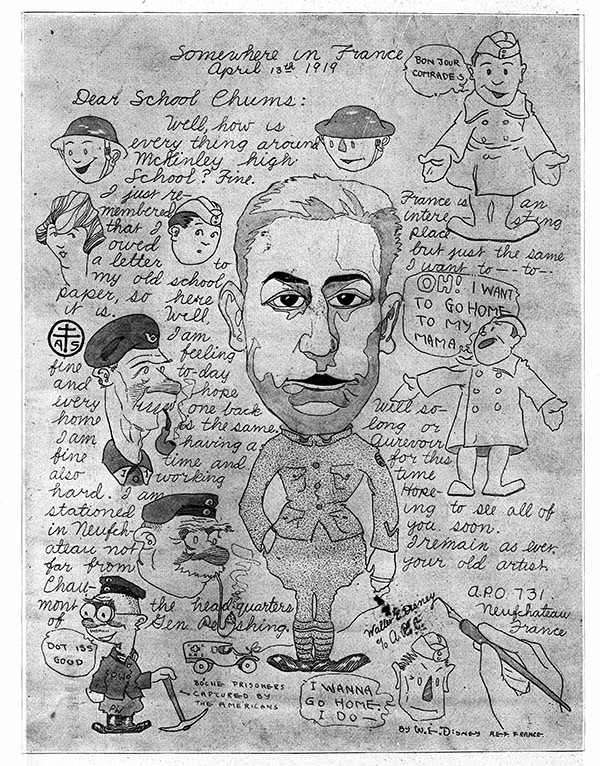
In 1918, Walt Disney joined the Red Cross Ambulance Corps. He was sent to France in November of that year, right as WWI was ending. This letter Disney sent from France in 1919 shows his self-portrait in uniform accompanied by other cartoon images of friends and officers.
Credit: Courtesy of the Walt Disney Archives Photo Library -

Walt Disney scoured the former battlefields of France looking for souvenirs to sell. Here Disney picks up an unexploded artillery shell. Walt Disney was discharged from the Red Cross in 1919 and returned home to America that October.
Credit: David Lesjak -

After returning home from the war, Walt Disney landed a job as a commercial artist at an ad company in Kansas City, MO. While there, he met fellow artist Ub Iwerks. When the two were laid off after the holiday rush, they began their own endeavor, Iwerks-Disney Commercial Artists, though the small business would be short-lived.
Credit: Courtesy of the Walt Disney Archives Photo Library -

Walt Disney and others advertise a film in Kansas City, MO. In 1921, Disney premiered his first animated short. He secured a contract to produce more, but upon delivery, the distributor refused to pay. Unable to pay the bills, Walt Disney's company, Laugh-O-gram Films, Inc., went under in 1923, and Walt moved to Los Angeles.
Credit: Courtesy of the Walt Disney Archives Photo Library -

In Los Angeles, Walt Disney partnered with his brother Roy to create Disney Bros. Studio, a two-man operation located in the back of a real estate office. Roy brought financial and business knowhow to the enterprise. Roy and Walt are pictured in front of their studio in 1923.
Credit: Courtesy of the Walt Disney Archives Photo Library -
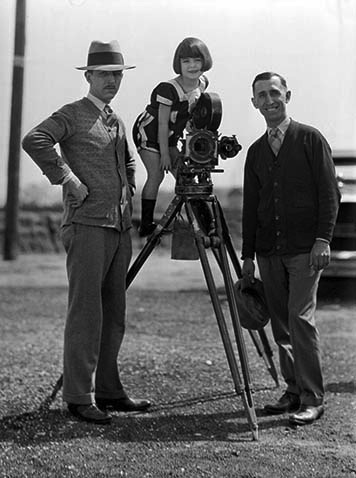
After moving to Los Angeles, Walt Disney was contacted by Margaret Winkler, a cartoon distributor interested in contracting one of his unfinished Laugh-O-gram projects, Alice's Wonderland. Disney shipped a print of his Alice film to Winkler's office, and she wired back an offer: 12 Alice shorts, the first six at $1,500 per episode and the next six at $1,800 each. Here, Walt poses with Roy Disney and Alice star Margie Gay in the 1920s.
Credit: Courtesy of the Walt Disney Archives Photo Library ©Disney -
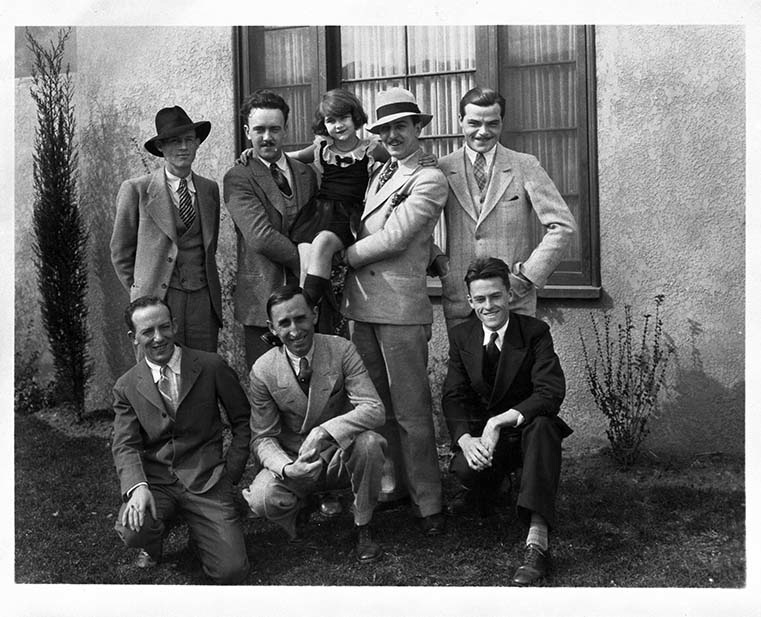
After the formation of Disney Bros. Studio, Walt Disney began hiring animators, including old friend and collaborator, Ub Iwerks (back row, second from left), who relocated from Kansas City to Los Angeles to work at Disney's studio in 1924.
Credit: Courtesy of the Walt Disney Archives Photo Library ©Disney -

Walt Disney and his future wife, Lillian, stand in front of Disney Bros. Studio on Kingswell Ave. in February, 1925. The two met in 1924 when Lillian started working at Disney Bros. Studio as an inker. They were married on July 13, 1925.
Credit: Courtesy of the Walt Disney Archives Photo Library -

In 1926, Walt and Roy Disney moved their business to a larger building on Hyperion Avenue, renaming it Walt Disney Studios. Walt is on the right in the front row in this Walt Disney Studios staff photo from 1929.
Credit: Courtesy of the Walt Disney Archives Photo Library ©Disney -

In 1928, Walt Disney and Ub Iwerks came up with a new character: Mortimer Mouse, soon known to the world as Mickey.
Credit: Disney Family Museum -

Walt Disney stands with some of his animators in the new animation building at Hyperion Studios in 1931. Walt Disney Studios grew with the success of Mickey Mouse, and Disney often worked until 1 or 2 o'clock in the morning. "In 1931 I had a hell of a breakdown," he later recalled, "I went all to pieces. It was just pound, pound, pound. […] And I-I cracked up."
Credit: David Lesjak -

Walt Disney later told people that his breakdown had been a godsend as it helped him realize there was more to life than work. After returning from a doctor-prescribed vacation, Disney took up a new exercise regimen and joined a polo league. 1935.
Credit: Courtesy of the Walt Disney Archives Photo Library ©Disney -

Walt and Lillian's daughter Diane was born December 18, 1933. Here, Disney plays with a young Diane in the front yard in 1936.
Credit: Courtesy of the Walt Disney Archives Photo Library ©Disney -

After a series of miscarriages, Walt and Lillian Disney adopted a second daughter, Sharon, in 1937. Walt, Diane and Sharon read a book in the girls' bedroom, 1939.
Credit: Courtesy of the Walt Disney Archives Photo Library ©Disney -

Walt Disney, in costume, plays on the floor with daughters Diane and Sharon in February 1939. Disney made a point to drive his two daughters to school every day, chase them around their house cackling like the wicked witch, and read them bedtime stories.
Credit: Courtesy of the Walt Disney Archives Photo Library ©Disney -

The Disney family poses at Elias and Flora's 50th wedding anniversary on New Year's Eve, 1937. Ray (right) and Roy (left) are standing behind Herb, Flora, Elias, and Walt. As an anniversary present, Roy and Walt bought their parents a house.
Credit: Courtesy of the Walt Disney Archives Photo Library ©Disney -

In 1939, Walt Disney won an honorary Oscar for his pioneering work in feature-length cartoons for *Snow White and the Seven Dwarfs.* While Disney expressed his pride to Shirley Temple at the ceremony (pictured), Disney felt that the upper echelons of Hollywood still didn't take his animation work seriously.
Credit: Corbis -

After Snow White and the Seven Dwarfs, Walt Disney embarked on three new ambitious projects, Pinocchio, Bambi, and the more experimental Fantasia. Here, he checks over musical scores in his hotel, April 4, 1939.
Credit: AP Images -

Walt Disney had seemingly boundless energy when developing projects. For Snow White and the Seven Dwarfs, he acted out each character in a complete scene to express his ideas to the staff. Here, he presents an idea for Fantasia.
Credit: Courtesy of the Walt Disney Archives Photo Library ©Disney -

In February 1940, Pinocchio premiered in New York. Despite its success in implementing innovative animation techniques and its popularity with both moviegoers and critics, the film did not generate enough of a profit to cover the cost of the company’s new studios or the soaring production costs of Fantasia and Bambi.
Credit: Courtesy of the Walt Disney Archives Photo Library ©Disney -

In 1941, many of the studio's artists went on strike. Walt Disney was taken by surprise and wrote to a friend that the situation had given him "a case of the D.D.'s – disillusionment and discouragement."
Credit: Getty Images -

With Bambi, released in 1942, Walt Disney was striving to push the limits of realistic animation, but some critics at the time denounced the realism as coming at the expense of magic and fantasy.
Credit: Courtesy of the Walt Disney Archives Photo Library ©Disney -
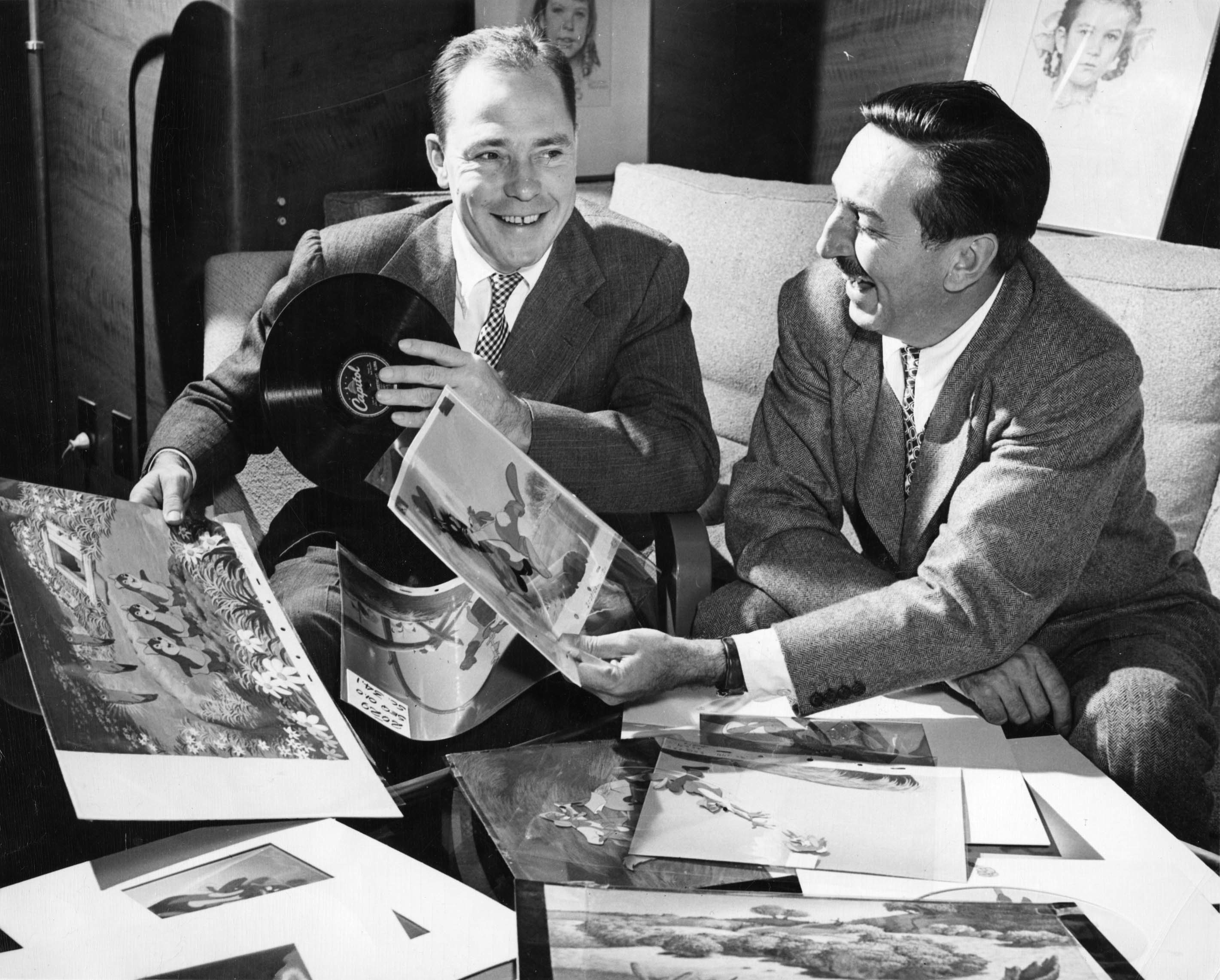
Song of the South was a departure from the European fairytales that had been the subject of Disney's previous feature films. Walt Disney told singer Johnny Mercer (left) that he had first heard the Uncle Remus stories as a boy, "And since then they’ve been one of my favorites."
Credit: Georgia State University -

Walt Disney catches a raindrop while standing near Lillian aboard the Queen Elizabeth ocean liner on December 7, 1946. Despite his fame, Disney insisted he was still a regular guy who got his haircuts at the company barbershop, drove himself to the office every day, and carried cans of his favorite chili-and-beans on trips to London or the French Riviera.
Credit: Motion Picture Herald/Georgetown -

In October 1947, Walt Disney was invited to testify before the House Un-American Activities Committee during a hearing on Communism in Hollywood. Disney named people he believed to be Communist sympathizers, including Herbert Sorrell, one of the leaders who had organized the 1941 strike against the Walt Disney Studios.
Credit: AP Images -

While Cinderella was under development at the studio, Walt Disney was pouring his creative energies into building his own scale model train at home. When surrealist painter Salvador Dali made a visit to Disney's house, he was taken aback at the ambition of Walt's endeavors, telling him "Such perfection [does] not belong to models!"
Credit: Courtesy of the Walt Disney Archives Photo Library ©Disney -

At the 26th Annual Academy Awards in 1954, Walt Disney took home four Oscars awarded for Best Documentary Feature, Best Documentary Short Subject, Best Short Subject Cartoon, and Best Short Subject Two-Reel. (He still holds the record for most individual Academy Awards won.) Despite this success, the coveted Best Picture nomination eluded Disney.
Credit: Getty Images -

When his daughters were younger, Walt Disney often took them them to amusement parks, but he struggled to find one that was clean and safe for children. In 1955, he opened his own family-friendly vacation destination in Anaheim, California: Disneyland. Here, Walt, Lillian, and Sharon Disney enjoy the teacup ride at Disneyland.
Credit: Courtesy of the Walt Disney Archives Photo Library ©Disney -

In July 1956, Walt Disney arrived in Marceline, Missouri to dedicate a park named in his honor. Although Walt Disney had spent nearly his entire childhood in Kansas City and Chicago, he called Marceline home. Here, Disney poses with a fish he caught at Yellow Creek, just down the road from the former Disney Farm.
Credit: Walt Disney Hometown Museum -

During the 1960s, Walt Disney was criticized for his films' focus on traditional and seemingly outdated themes. When one critic said Disney's films were too corny, Walt told his son-in-law, "I like corn. I love corn. That’s what I’m all about."
Credit: AP Images -

Despite the success of his films and of Disneyland, Walt Disney hoped to leave behind an even greater legacy. He began planning his Experimental Prototype Community of Tomorrow, or EPCOT, to be featured as part of Florida's Walt Disney World. The project was very personal to Walt Disney. During a planning meeting he remarked, "I’m going to put this little park bench right here, and Lilly and I are going to sit here. We're going to watch people."
Credit: Courtesy of the Walt Disney Archives Photo Library ©Disney -

Walt Disney looks over plans for Walt Disney World with Vice President of Marketing, Card Walker, in Florida. Walt never saw the completion of EPCOT as he died of lung cancer on December 15, 1966.
Credit: Courtesy of the Walt Disney Archives Photo Library ©Disney








